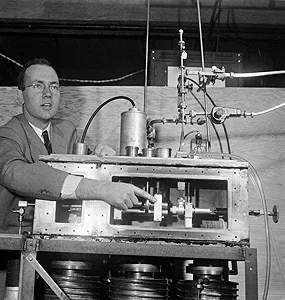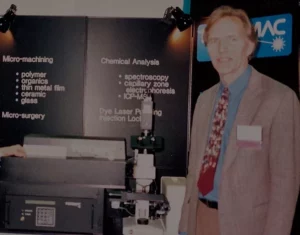
Last week the laser community was saddened to learn of the death of Charles Townes, one of the inventors of the laser. Light Amplification by Stimulated Emission of Radiation [LASER] devices are such a part of 21st century life that we now take them for granted but they are a fairly recent 20th century invention. Dr. Townes earned a Nobel Prize with colleagues in 1964 for his contribution to a technology that we now find in everything from CD players to supermarket scanners.
Dr. Townes had particular impact on Potomac’s Founder, Paul Christensen, whose graduate studies centered on laser technology and new types of lasers. “While a graduate student at Berkeley, I had the opportunity to hear Prof. Townes speak a couple of times. I was always impressed by the breadth of his understanding of the physical world. He was as comfortable talking about infrared astronomy in the Milky Way as about quantum effects in molecular rotation,” remembers Dr. Christensen.
Without lasers, Potomac might not exist, as the company was founded to commercialize a miniaturized excimer laser that Dr. Christensen had invented in the early 1980’s. We soon realized that one of the major applications of the new laser was micromachining and the rest, as they say, is history.

Lasers play an important role in manufacturing. The interaction between laser light and a material allows for unique properties of cutting, drilling or welding processes. Excimer lasers in particular are not a thermal process and so materials such as organic polymers can be cut with little or no Heat Affected Zone [HAZ].
Perhaps one of the most useful properties of laser light is the ability to focus to small spot sizes. As we get to the shorter excimer wavelengths such as 248 or 193 nm, it’s possible to drill holes as small as 1 micron in diameter. This had particular usefulness in the microelectronics industries and IBM was one of Potomac’s first customers for failure analysis equipment in the late 1980’s.
The medical field seems to have been most strongly impacted by lasers. Direct laser surgery is commonplace, but also the medical devices we take for granted such as stents were made possible by laser micromachining. Implantable medical devices need to be small and the laser’s inherent ability to focus to small spot sizes makes it a natural choice for manufacturing these products. Today the bulk of Potomac’s micromachining work is in medical device and Biotech applications.
Many people do not realize it, but the first 3D Printers designed by Chuck Hull, the founder of 3D Systems, used gas lasers. Today, Solid State lasers have replaced these larger, less robust light sources to make 3D printing accessible to mainstream markets. Potomac integrates 3D Printing with laser micromachining in many applications, taking advantage of the best attributes of each technology.
We, at Potomac, are most thankful to Dr. Townes for his powerful invention that has driven so many applications that are cool and in many cases, life-saving. His is a legacy that lives on each day that we go to work to use the fantastic tools enabled by Dr. Townes’ invention, the laser.

